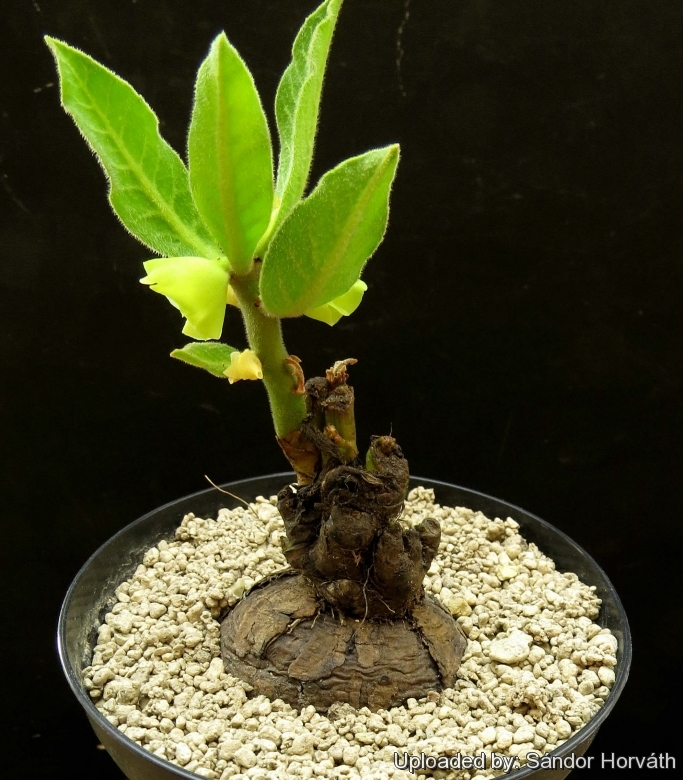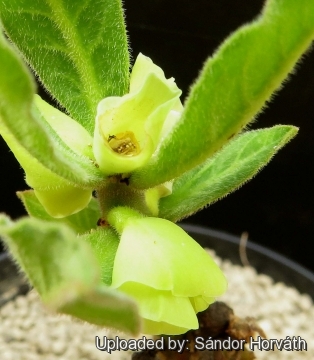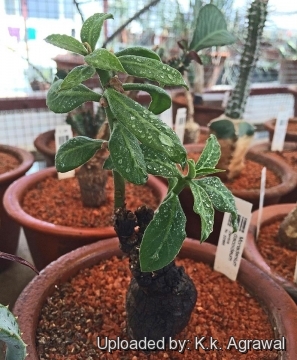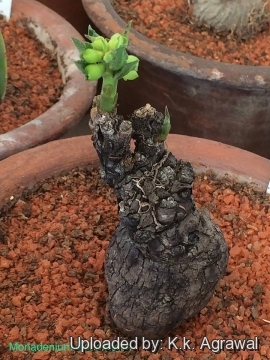
Euphorbia discoidea Photo by: Sándor Horváth
Origin and Habitat: Euphorbia discoideaSN|29534]]SN|29534]] is restricted overall to an area north of Kitwe, Democratic Republic of the Congo and nearby Zambia (Western Prov.).
Altitude range: 1200–1300 metres above sea level.
Habitat and ecology: This species grows in open deciduous Brachystegia woodland
Synonyms:
Common Names include:
CHINESE (中文): 美花大戟
Description: Euphorbia discoideaSN|29534]]SN|29534]], much better known under its old name Monadenium discoideumSN|29535]]SN|29535]], is a geophytic perennial herb, with a tuberous root, also called a caudex, with fleshy upright annual stems topped with a leaf crown. All above-ground parts hairy. The flowers are yellowish-green or often flushed reddish.
Caudex (rootstock): Blackish, tuberous, up to c. 7 × 5 cm, producing a few to several simple erect stems 15-25 cm high; the whole plant densely covered with short, bristly, stiff hairs.
Leaves: Subsessile, rosulate, crowded at the tip of the annual stems, obovate to oblanceolate, to 4-6.5 cm long. Margins entire. Stipules glandular, c. 0.5 mm in diameter.
Inflorescences (cymes): Axillary, simple, pinkish-yellow; peduncles to 6 mm long; Bract-cup nodding, to 11 x 18 mm rounded with lobes indistinct, not or only slightly notched and completely enveloping the involucre, yellowish-green or often flushed reddish. Peduncles c. 6 mm long.
Flowers (cyathia): 4-4.5 long, 3.5-4 mm im diameter, with barrel-shaped involucres. Nectar-gland rim c. 1.5-2 mm hight, yellowish. Lobes c. 1 × 1 mm, rounded, denticulate.
Male flowers: Bracteoles few, c. 2 mm long. Stamens c. 3.5 mm long.
Female flower: Perianth distinctly 3-lobed, 3 mm in diameter. Ovary subglobose, indistinctly ridged, minutely bristly, styles 0.75 mm long, with bifid apices.
Fruits (capsule): Obtusely lobed, bristly, about 4 mm long and 3.5 mm across, and exserted on a reflexed pedicel 5 mm long.
Seeds: Subglobose. 2-2.25 x 1.7- 2 mm, black, smooth, caruncle present, c. 1 mm in diameter, cap-like, shortly stipitate, pale yellow.
Bibliography: Major references and further lectures
1) S. Carter & L.C. Leach “Flora Zambesiaca”, Vol 9 Part 5 2001
2) Urs Eggli “Illustrated Handbook of Succulent Plants: Dicotyledons” Springer Science & Business Media, 2002
3) P.R.O.Bally. Candollea 17: 26 1959
4) Bruyns. Taxon 55: 412 2006
 Euphorbia discoidea Photo by: Sándor Horváth
Euphorbia discoidea Photo by: Sándor Horváth Euphorbia discoidea Photo by: K.k. Agrawal
Euphorbia discoidea Photo by: K.k. Agrawal - Monadenium discoideum's caudex is charcoal black, if found in forest nobody will touch it because it looks more of an animal dropping!!! Photo by: K.k. Agrawal
- Monadenium discoideum's caudex is charcoal black, if found in forest nobody will touch it because it looks more of an animal dropping!!! Photo by: K.k. AgrawalSend a photo of this plant.The gallery now contains thousands of pictures, however it is possible to do even more. We are, of course, seeking photos of species not yet shown in the gallery but not only that, we are also looking for better pictures than those already present.
Read More... Cultivation and Propagation: Euphorbia discoideaSN|29534]]SN|29534]] (Monadenium discoideumSN|29535]]SN|29535]]) is an interesting addition to a collection, but rarely seen in cultivation.
Growth rate: It grows well, though very slowly, but it possible to increase the speed of growth to some extent by providing adequate amount of water, warmth, and fertilizer during the active growing season, but it’s susceptible to rotting if too wet.
Exposure: It needs light shade, but the caudex should be in the shade, while the leaves prefer some sun. Avoid direct blasting sun in summer. Bright light if grown indoors.
Soil: In pots it needs a very porous potting medium (add pumice, vulcanite, and perlite). It does better in a rather acidic soil.
Waterings: Water frequently while plant is in full growth, but keep dry during the winter after the branches have died back. It rot easily and do NOT like a lot of water when it has no leaves.
Fertilizer: Benefits from moderate doses of a well-balanced, slow-release fertilizer.
Frost tolerance: Due to its African origin keep warm in winter, the minimum safe average temperature is 15°C, although it can go lower for short periods. It can be grown outdoors in frost-free climates, need anyway to kept above 10°C and dry in winter. It is very prone to rot in cool, wet conditions. USDA Zone 10-12, but does very well in containers.
Manteinance: Repot every two years. It like pots with generous drain holes. In the winter, the branches die back and should be cut back to encourage rebranching, to maintain an attractive shape and to ensure caudex habit.
Pest and diseases: White meldew, mould and other fungi.
Propagation: The species can be propagated by both seeds and cuttings. The plants for seed production are generally grown from cuttings since these bloom more freely. The plants for decoration are grown from seed since they develop a caudex.














